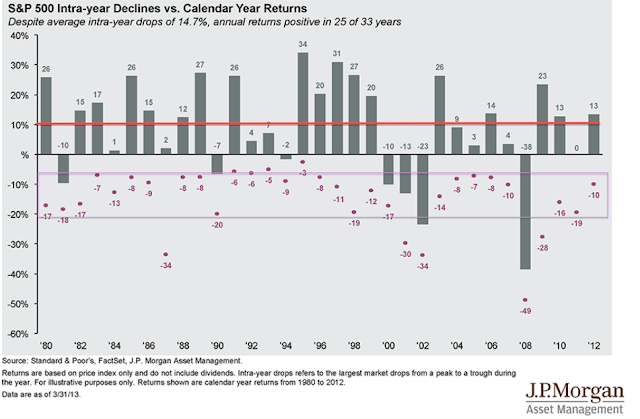The Fat Pitch is about finding the circumstances where your expected return (upside) is a high multiple to your expected risk (downside). This blog attempts to combine a variety of measures to portray the expected risk/return at any given time.
In general, the odds on the long side are strongly in your favor. Since 1980, the average annual gain for SPX is 9.5% (median is 13%). Every January 1st, that is your expected return over the next 12 months. The probability of making any positive return each year is 76%.
Also since 1980, the average intra-year decline for SPX is 14.7% (median is 11%). Every January 1st, an investor should expect to incur this level of drawdown sometime during the course of the year. Drawdowns of at least 8% occur more than 80% of the time. Drawdowns of at least 15% occur nearly 40% of the time. If you think that you will only suffer a small pullback of under 5% this year, the odds are very strongly against you; this has happened just once in 33 years.
So, what does this mean for our current situation?
SPX has risen 10% year to date. This is already a full year of gains in a typical year. The probability of further gains than this for the whole year are just over half. In other words, it's a coin toss.
Strong starts to the year improve the odds of a positive full-year, but the gains after the first quarter are much smaller. Bespoke (post) notes that a strong start like this one leads to an average gain over the next 9 months of just 1.4% (median of 5.8%). If you buy and hold now, that is your expected return thru the end of the year. The big gains for 2013 are likely behind us.
Against this return you should weigh the average annual drawdown. The upshot is this: right now, on average, your expected risk is 10 times your expected return (14.7% drop vs 1.4% gain). Using median values, your expected risk is twice your expected return (11% drop vs 5.8% gain). These are poor risk profiles, especially in comparison to those at the start of the year.
The risk-return does not improve when you only look at positive years either. Assuming you knew with certainty that this year would end with a gain of at least 10%, what would be your expected drawdown? The answer is 12%, very close to average and the median.
These results are what we would expect. Last week we looked at strong positive gains in 1Q in the Dow and discovered that many occurred when the prior year was either flat or down. In the other years, like 2013, all of the 1Q gains were entirely given up in 2Q (post).
The probability of a large gain happening during the next few months before a large drawdown is also small. Since 1980, 88% of corrections have happened by the end of May and 85% by the first week in April (post).
2013 is an unusual year in that it is presenting a particularly tight set of circumstances: strong gains and no correction thru the first 3 months. There are never certainties in the market, but the odds are clearly not in your favor until some of the gains from the first quarter have been given back.
The chart below shows the calendar year gains and intra-year drops in SPX since 1980. The red line is the average gain; the purple box captures over 80% of the drops.
